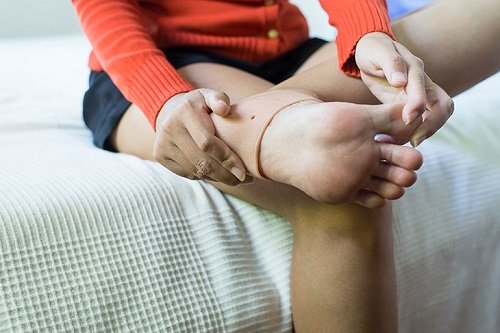Plantar Fasciitis
Plantar fasciitis is a common foot condition characterized by inflammation and pain in the plantar fascia, a thick band of tissue that runs along the bottom of your foot, connecting the heel bone (calcaneus) to the toes. This tissue plays a crucial role in supporting the arch of your foot and acts as a shock absorber during walking and running.The primary symptom of plantar fasciitis is pain, typically felt in the heel and along the arch of the foot.
The plantar fascia connects the heel bone (calcaneus) to the toes and plays a crucial role in supporting the arch of the foot and absorbing shock during activities like walking and running.

Symptoms of Plantar Fasciitis include:
Heel Pain: The hallmark symptom of plantar fasciitis is sharp, stabbing pain in the bottom of the heel. The pain is often most severe when you take your first steps in the morning or after long periods of rest, and it may gradually improve as you continue to walk or move around.
Pain During Activity: The pain typically worsens with prolonged standing, walking, running, or climbing stairs. Activities that put strain on the plantar fascia can exacerbate the discomfort.
Stiffness: Many individuals with plantar fasciitis experience stiffness and aching in the heel and arch of the foot.
Cause of Plantar Fasciitis
Overuse: Repeated stress and strain on the plantar fascia, often from activities like running, walking long distances, or standing for extended periods, can lead to inflammation and injury.
Foot Anatomy: Flat feet or high arches can increase the risk of plantar fasciitis by altering the way weight is distributed on the foot and placing extra strain on the fascia.
Improper Footwear: Wearing shoes with inadequate arch support or poorly cushioned soles can contribute to the development of plantar fasciitis.
Age: Plantar fasciitis is more common in adults between the ages of 40 and 60.
Obesity: Excess body weight places additional stress on the plantar fascia, increasing the likelihood of inflammation and pain.
Tight Calf Muscles: Tightness in the calf muscles can affect how your foot functions and may contribute to plantar fasciitis.
Treatment for Plantar Fasciitis
Rest: Giving your feet a break from activities that aggravate the condition can help with healing.
Stretching Exercises: Gentle stretching exercises for the calf muscles and Achilles tendon can help relieve tension on the plantar fascia.
Orthotics: Custom or over-the-counter shoe inserts can provide additional arch support and cushioning.
Appropriate Footwear: Wearing shoes with good arch support and cushioning can alleviate strain on the plantar fascia.
Ice and Anti-Inflammatory Medications: Applying ice and taking over-the-counter anti-inflammatory medications can help reduce pain and inflammation.
Physical Therapy: A physical therapist can guide you through exercises and treatments to improve flexibility and strength in your feet and lower legs.
Night Splints: These devices help keep the plantar fascia stretched overnight, reducing morning pain.
Several Benefits
Pain Relief: One of the primary benefits of treating plantar fasciitis is pain relief. The discomfort and pain associated with this condition can be quite intense, particularly during the first steps in the morning or after prolonged periods of standing or walking. Treatment options can help alleviate this pain.
Improved Mobility: Plantar fasciitis can limit your ability to move comfortably. By addressing the condition, you can regain your mobility and participate in activities without experiencing pain and discomfort.
Prevention of Complications: If left untreated, plantar fasciitis can lead to complications like chronic heel pain, changes in walking or running patterns (which can cause other injuries), and the development of heel spurs. Treating it early can help prevent these complications.
Non-Invasive Treatments: Many treatments for plantar fasciitis are non-invasive or minimally invasive. This means you can manage your condition without the need for extensive surgery or long recovery periods.
